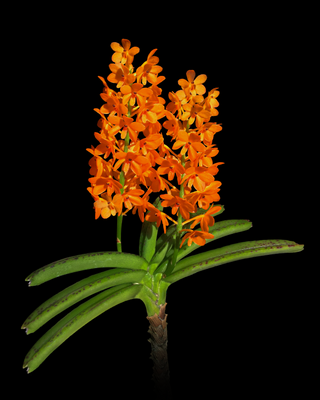
A raceme or racemoid is an unbranched, indeterminate type of inflorescence bearing flowers having short floral stalks along the shoots that bear the flowers. The oldest flowers grow close to the base and new flowers are produced as the shoot grows in height, with no predetermined growth limit. Examples of racemes occur on mustard and radish plants.

Ornamental grasses are grasses grown as ornamental plants. Ornamental grasses are popular in many colder hardiness zones for their resilience to cold temperatures and aesthetic value throughout fall and winter seasons.

Carex angustata is a species of sedge known by the common name widefruit sedge. It is native to the western United States from Washington and Idaho to California, where it grows in wet meadows and on streambanks.
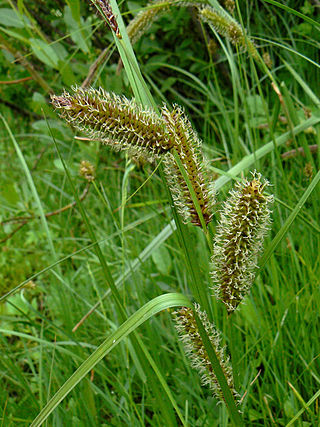
Carex aquatilis is a species of sedge known as water sedge and leafy tussock sedge. It has a circumboreal distribution, occurring throughout the northern reaches of the Northern Hemisphere. It grows in many types of mountainous and arctic habitat, including temperate coniferous forest, alpine meadows, tundra, and wetlands.
Carex arcta is a species of sedge known by the common name northern cluster sedge. It is native to northern North America including most of Canada and northern parts of the United States. It grows in wet areas, especially in coniferous forests. This sedge produces dense clumps of erect stems up to about 80 centimetres (31 in) high. The leaves are pale green to grayish, flat, and have reddish or purple-dotted sheaths at the base, and they are sometimes longer than the stems. The inflorescence is a dense, oblong cluster of up to 15 spikes of pointed flowers, each cluster up to 3–4 cm (1.2–1.6 in) long and each individual spike up to 1 cm (0.39 in) long. The fruit is covered in a sac called a perigynium which is greenish and veined with a reddish tip.

Carex cusickii is a species of sedge known by the common name Cusick's sedge. It is native to Northwestern North America from British Columbia to California, and in Utah, where it can be found in several types of wet habitat, such as marshes, mountain meadows, and ditches. In its range it is most common in the Cascade Range and areas west.

Carex douglasii is a species of sedge known by the common name Douglas' sedge.
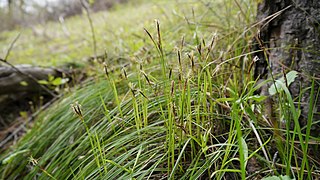
Carex geyeri is a species of sedge known by the common names Geyer's sedge and elk sedge. It is native to western North America from British Columbia to California to Colorado, where it grows in dry areas in mountain meadows, grasslands, and open forest. This sedge produces scattered tufts of stems connected by a network of long rhizomes. The stems are triangular in cross-section and approach half a meter in maximum height. The inflorescence is composed of a cluster of staminate flowers and a cluster of pistillate flowers separated by a node.

Carex hassei is a species of sedge known by the common name salt sedge. It is native to western North America from British Columbia to Baja California to New Mexico, where it grows in moist places, such as meadows.

Carex lenticularis is a species of sedge known by the common names lakeshore sedge and goosegrass sedge. It is native to much of northern North America, including most all of Canada and the western United States, where it grows in wet habitats.

Carex mertensii is a species of sedge known by the common name Mertens' sedge. It is native to western North America from Alaska to California to Montana, where it grows in moist and wet habitat in mountain forests and meadows. This sedge produces clumps of stems reaching maximum heights between 80 and 120 centimeters. The leaves are small; those toward the bases of the stems are reduced to sheaths only. The inflorescence is a densely packed, bullet shaped cluster of overlapping flowers, mainly hanging on long peduncles. Each inflorescence is generally 2 to 4 centimeters long. Each of the flowers has a dark-colored bract.
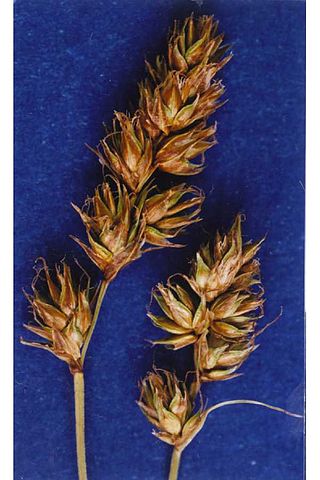
Carex occidentalis is a species of sedge known by the common name western sedge. It is native to the southwestern United States and parts of the west as far north as Montana. It grows mainly in dry habitat such as woodland and grassland. The plant produces very narrow stems up to about 90 centimeters in maximum height, sometimes with rhizomes. The inflorescence produces a cluster of several rounded flower spikes. The pistillate flowers are covered in scales which are brown with green, three-veined centers.
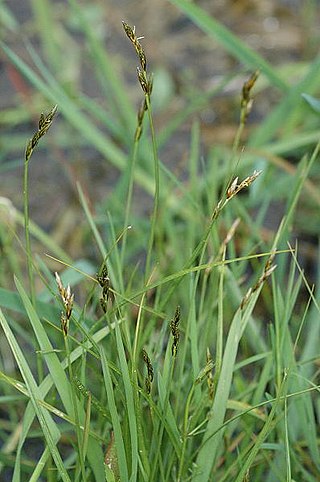
Carex leporina is a species of sedge known in the British Isles as oval sedge and in North America as eggbract sedge. It is native to Eurasia and eastern and western North America, where it grows in seasonally wet habitat, such as meadows and fields. This sedge produces many thin stems and narrow leaves. The inflorescence is an open cluster of several flower spikes. The pistillate flower has a reddish or brownish bract with a gold center and white tip.

Carex praegracilis is a species of North American sedge known as clustered field sedge, field sedge, and expressway sedge. Carex praegracilis is cultivated in the specialty horticulture trade as lawn substitute and meadow-like plantings.
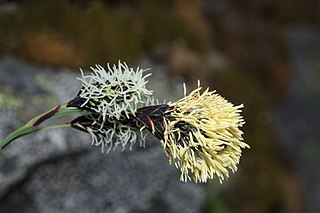
Carex spectabilis is a species of sedge known by the common name showy sedge.
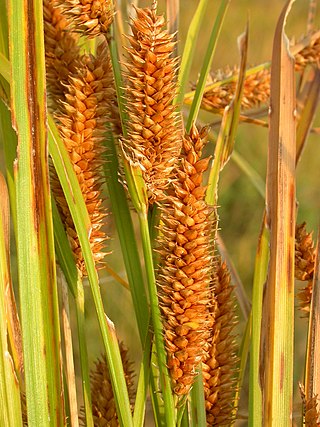
Carex utriculata is a species of sedge known as Northwest Territory sedge and common yellow lake sedge.
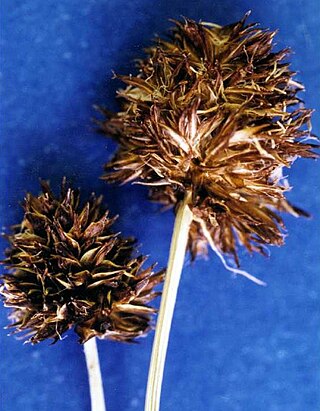
Carex vernacula is a species of sedge known by the common name native sedge.

Carex eburnea, known as ivory sedge, ebony sedge, and bristleleaf or bristle-leaved sedge, is a small and slender sedge native to North America, from Alaska and Newfoundland south to central Mexico.

Carex kobomugi is a species of sedge, known as the Japanese sedge or Asiatic sand sedge, that lives in sandy coastal areas of eastern Asia, and has become an invasive species in the north-eastern United States.

Carex muehlenbergii is a species of flowering plant, it is a type of sedge. It is a grass-like plant in the family Cyperaceae. Its common names include sand sedge, Muhlenberg's sedge.



















